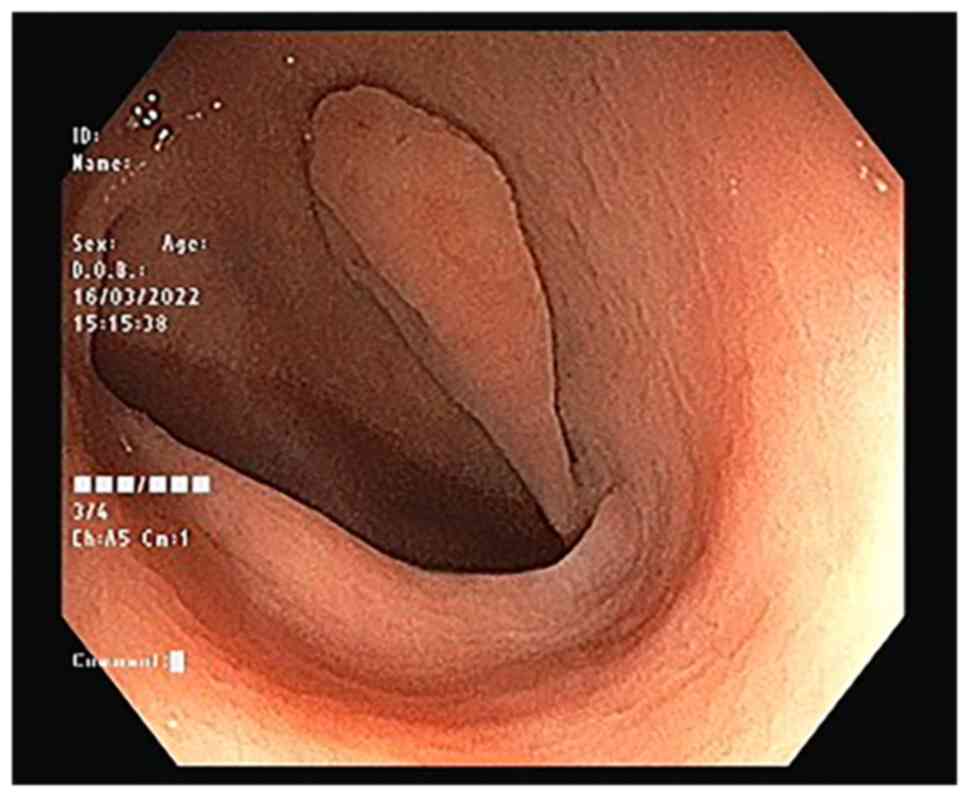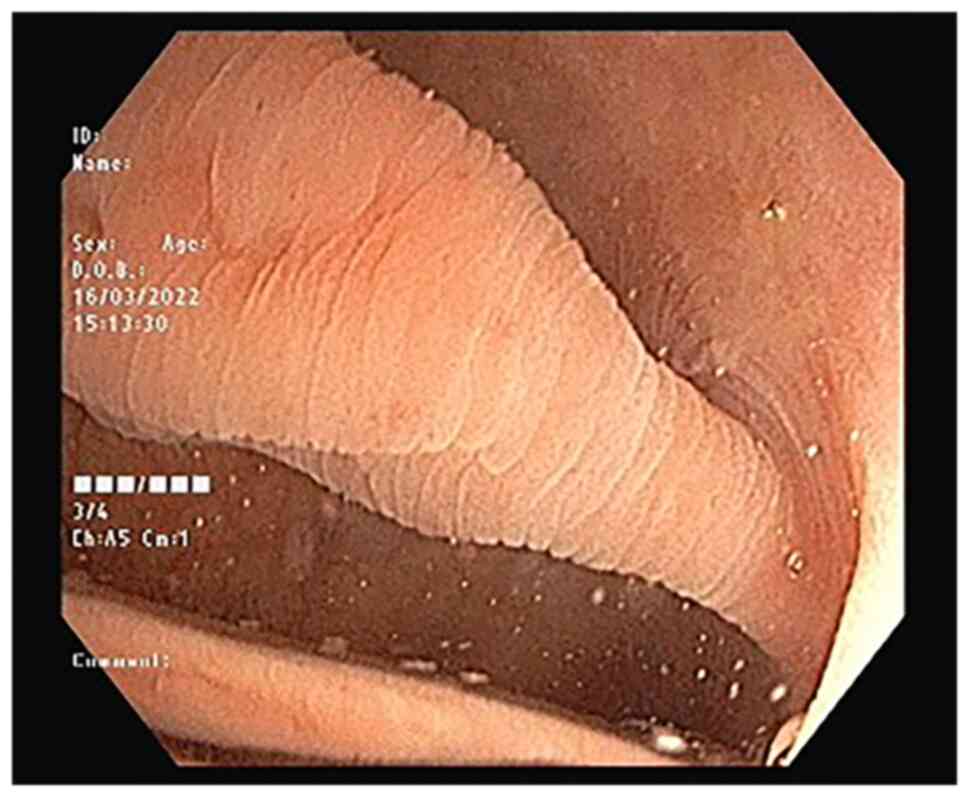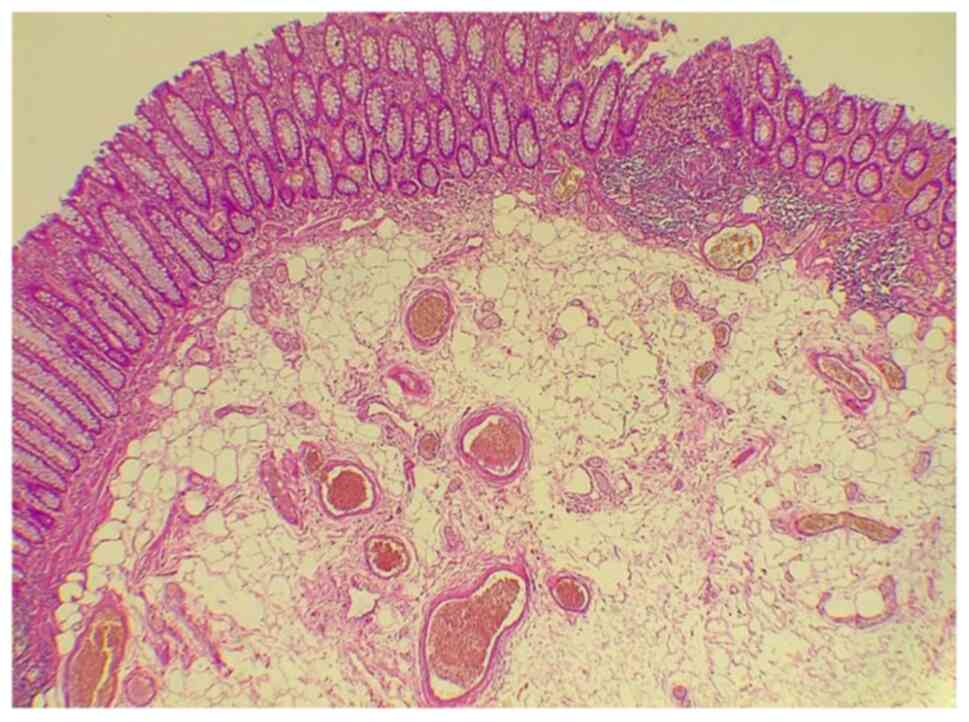Introduction
Diverticula refer to mucosal and submucosal pouches
bulging from the muscularis propria. Inverted colonic diverticulum
(ICD) is an infrequent incident occurring in ~0.7-1.7% of the
general population, with a few reported cases in the literature
(1). Due to the resemblance of this
atypical lesion with polyps, conducting an accidental biopsy or
polypectomy may result in perforation, and an increase in the rate
of morbidity and mortality. Therefore, recognizing this entity by
endoscopists is critical for preventing life-threatening
complications (1). Concentric rings,
known as Aurora rings, around the base of the ICD, are among the
major endoscopic features of the condition. According to the
literature, their appearance is regarded as evidence of this
phenomenon (2-4).
Colonic lipomas are submucosal benign tumors of adipose tissue that
may be detected incidentally during colonoscopy, diagnostic
imaging, surgery and biopsy. They are the second most common
colonic benign tumors, following adenomatous polyps. However, their
incidence is estimated to be ~0.2-4.4% (5). Several cases of ICD mimicking colon
polyps have been reported (1,6,7).
To the best of our knowledge, the appearance of
Aurora rings with a colonic lipoma in colonoscopy screening has not
yet been mentioned. The present study reports a case of colonic
lipoma with Aurora rings, which contradicts the assumption that
Aurora rings are indicative or pathognomonic of ICD.
Case report
Patient information
A 52-year-old male patient presented to the GIT
Department, at Smart Health Tower (Sulaimani, Iraq) with left-sided
abdominal pain for >1 year, associated with constipation in the
form of decreased bowel movements every 4 to 5 days. The patient
had a good appetite and did not experience weight loss, rectal
bleeding, or any notable previous surgical history. The only known
medical condition was hypertension, for which the patient was
taking hydrochlorothiazide. The patient was an outpatient who had
ignored his condition until the pain progressed to severe pain, and
he then visited the hospital for his condition.
Clinical findings
A physical examination revealed an obese,
protuberant abdomen and a mildly tender left iliac fossa region.
There were no other notable findings.
Diagnostic assessment
Blood examinations revealed normal blood glucose and
serum creatinine levels, and a complete blood count. A
transabdominal ultrasonography (US) revealed a thickening of the
large bowel wall (<7 mm), with a suspected inflammatory lesion
on the left side of the colon. There was no obvious collection or
mass. An ileocolonoscopy revealed multiple, different-sized diffuse
diverticula involving the entire colonic mucosa, with a large (1.5
cm) thick stalk pedunculated polyp in the sigmoid colon (Fig. 1). The polyp had a collapsed tip,
along with mucosal rings on the polyp stalk and the surrounding
mucosa at the base, confirming the presence of Aurora rings
(Fig. 2).
Therapeutic intervention
Following discussions with an expert
gastrointestinal surgeon, a polypectomy through endoscopy was
conducted with the deployment of two hemoclips at the polyp base to
prevent perforation, as an ICD was suspected in this case. A
histopathological examination was performed under the following
conditions: The sections (4-5 µm-thick) were paraffin-embedded and
fixed with 10% neutral-buffered formalin at room temperature for 24
h. The sections were then stained with hematoxylin and eosin (Bio
Optica Co.) for 1-2 min at room temperature and examined under a
light microscope (Leica Microsystems GmbH). The histopathological
examination of a specimen (polyp, 1.3 cm) revealed the presence of
a colonic lipoma, rather than an ICD (Fig. 3).
Follow-up
Post-operatively, the patient had only mild
abdominal pain, and he was admitted to the hospital for 24 h. Later
on, his condition recovered, and the patient was discharged.
Discussion
The ICD is a rare condition, affecting ~0.7-1.7% of
the general population, with a higher prevalence among males. It
predominantly occurs in the sigmoid colon and manifests as a
polypoid lesion, presenting either as a sessile morphology or
pedunculated structures (1,2). It is considered that this lesion may
initially grow as a typical diverticulum and then reverse
intermittently in response to changes in intraluminal and
intra-abdominal pressure (2). The
entity has a number of similarities with colon polyps; thus, it can
be misdiagnosed and can cause iatrogenic events with severe
complications such as perforation following a biopsy or polypectomy
(6).
Recently, scholars have focused on techniques that
can identify the main features of an ICD, aiding endoscopists in
making better diagnoses. The radiating pillow sign has been
reported to be critical in differentiating an ICD from a lipoma
(4,8). Furthermore, several endoscopic
maneuvers can make the diagnosis of ICD possible, such as trying to
revert the lesion with forceps, air insufflation, or a water jet
(4,9). However, unrecognizing it through these
techniques and features cannot rule out ICD due to its varying
morphology and sites of occurrence (1,7). Aurora
rings, a series of concentric rings around the base of the lesion,
have recently attracted the interest of endoscopists in the
diagnosis and differentiation of ICD from colonic polyps (2,4,6).
These concentric rings were first described during
the endoscopic screening of the colon in several cases by a
gastrointestinal technical specialist named Aurora. Aurora and her
colleagues claimed that visualizing these rings may provide
evidence of ICD without the need for endoscopic maneuvers (4). After Aurora's finding, Aurora rings
have become one of the major endoscopic features in diagnosing ICD;
however, their etiology remains unknown (4). Based on an extensive search of the
literature, the authors could not find any study mentioning the
appearance of Aurora rings in an endoscopic screening of other
colonic conditions rather than ICD (2,4,6). As a result, to the best of our
knowledge, the present study may be the first to report the
visualization of Aurora rings with a colonic lipoma, thus casting
doubt on the assumption that these rings are indicative of ICD.
Colonic lipoma is a rare benign tumor with an
unknown etiology that may be asymptomatic or cause blood loss,
abdominal pain and bowel obstruction (5). This tumor most commonly affects the
ascending colon, although it can grow in other sites, such as the
sigmoid colon, descending colon and transverse colon (10). Colonic lipoma typically manifests in
individuals between the ages of 50 and 70, with a higher prevalence
observed among females (5). An
inflammatory response, chronic intestinal irritation and fat tissue
aggregation are the factors hypothesized to be responsible for the
development of colonic lipomas (10). Upon an endoscopy, a colonic lipoma
appears as a well-delineated, soft, yellowish-round sessile or
pedunculated tumor. Based on the location of the lipoma in the
submucosa, several endoscopic signs can guide to proper diagnoses,
such as the cushion sign (probing the polyp using closed biopsy
forceps may demonstrate a pillow-like indentation), a tent-like
appearance by overlying mucosal grasping with biopsy forceps and
detecting a naked fat sign following a biopsy (5). However, some researchers have mentioned
the possibility of misdiagnosing lipoma as an ICD (9), although, to the best of our knowledge,
no study to date has reported the appearance of Aurora rings with
lipoma.
The management of colonic lipoma depends on the
lesion size and presentation. Small, asymptomatic lesions may only
require follow-up. Symptomatic lesions or asymptomatic lesions
>2 cm in size require resection, either surgical or endoscopic.
Endoscopic resection is considered more suitable for managing
symptomatic lipomas that are <2 cm in diameter or are
pedunculated. However, it should be noted that performing
endoscopic resection on lipomas >2 cm is associated with a
greater risk of complications, such as hemorrhaging and perforation
(5). In addition, cold snare
polypectomy has been suggested as a safe and effective technique
for managing polyps ~1 cm in size. On the other hand, snare cautery
appears to be safer for suspected ICD lesions (1). In line with the literature, the case
described herein was that of a 52-year-old patient who presented
with abdominal pain associated with constipation. A transabdominal
US revealed a large bowel wall thickening with a suspected
inflammatory lesion. An ileocolonoscopy detected a large, thick,
stalk pedunculated polyp in the sigmoid colon with the appearance
of Aurora rings, suggesting ICD. The case was managed by performing
a polypectomy with the deployment of two hemoclips at the base of
the polyp to avoid perforation. Unexpectedly, the histopathology
report of a 1.3-cm polyp specimen revealed it to be a colonic
lipoma.
In conclusion, the presence of Aurora rings with a
colonic lipoma has not been previously reported, at least to the
best of our knowledge. The finding of this report challenges the
assumption that Aurora rings are solely indicative of ICD.
Consequently, distinguishing ICD from lipomas and polyps becomes
more complex, thus necessitating an extensive workup.
Acknowledgements
Not applicable.
Funding
Funding: No funding was received.
Availability of data and materials
The datasets used and/or analyzed during the current
study are available from the corresponding author on reasonable
request.
Authors' contributions
DTG was a major contributor to the conception of the
study, and to the management of the case. HOA, BAA and FHK were
involved in the literature review, writing of the manuscript, and
the examination and interpretation of the patient's data. MK, FA,
HRA, KFHH, DAI and HHKA were involved in the literature review, the
critical revision of the manuscript, and in the processing of the
figures. OHGH and DHA were involved in the management of the case
presented herein. OHGH and DHA confirm the authenticity of all the
raw data. AMA was the radiologist who performed the assessment of
the case. All authors have read and approved the final
manuscript.
Ethics approval and consent to
participate
Written informed consent was obtained from the
patient for his participation in the present study.
Patient consent for publication
Written informed consent was obtained from the
patient for the publication of the present case report and any
accompanying images.
Competing interests
The authors declare that they have no competing
interests.
References
|
1
|
Canakis A, Hopkins M and Parian A: Large
pedunculated polyp diagnosed as inverted colonic diverticula. ACG
Case Rep J. 4:e96–e98. 2017.PubMed/NCBI View Article : Google Scholar
|
|
2
|
Cocomazzi F, Carparelli S, Cubisino R,
Giuliani AP, Bossa F, Biscaglia G, Parente P, Andriulli A, Perri F
and Gentile M: Inverted colonic diverticulum (ICD): Report of two
cases and literature review of a not that unusual endoscopic
challenge. Clin Res Hepatol Gastroenterol.
45(101711)2021.PubMed/NCBI View Article : Google Scholar
|
|
3
|
Mak WY, Hui YT and Lam JTW: Should we
perform polypectomy or not? Hong Kong Med J. 20(351.e3)2014.
|
|
4
|
Share MD, Avila A, Dry SM and Share EJ:
Aurora rings: A novel endoscopic finding to distinguish inverted
colonic diverticula from colon polyps. Gastrointest Endosc.
77:308–312. 2013.PubMed/NCBI View Article : Google Scholar
|
|
5
|
Farfour AN, AbuOmar NA and Alsohaibani FI:
Large lipoma of the ascending colon: A case report and review of
literature. J Surg Case Rep. 2020(rjaa354)2020.PubMed/NCBI View Article : Google Scholar
|
|
6
|
Chang HC: Inverted colonic diverticulum
mimic colon polyp: A case report and review. Adv Dig Med.
9:255–257. 2021.
|
|
7
|
Paoluzi OA, Tosti C, Andrei F, Stroppa I
and Pallone F: Look out before polypectomy in patients with
diverticular disease-a case of a large, inverted diverticulum of
the colon resembling a pedunculated polyp. Can J Gastroenterol.
24:61–63. 2010.PubMed/NCBI View Article : Google Scholar
|
|
8
|
Yusuf SI and Grant C: Inverted colonic
diverticulum: A rare finding in a common condition? Gastrointest
Endosc. 52:111–115. 2000.PubMed/NCBI View Article : Google Scholar
|
|
9
|
Gulaydin N, Iliaz R and Ersoz F: Inverted
colonic diverticulum: An endoscopic examination and presentation. J
Dig Dis. 22:152–158. 2021.PubMed/NCBI View Article : Google Scholar
|
|
10
|
An HH, Duong TT, Van Truong N, Van Quoc L,
Son VN, Thang NP, Van Thach N, Cuong DD and Duc NM: A large lipoma
of the descending colon: A rare case report. Radiol Case Rep.
16:3396–3399. 2021.PubMed/NCBI View Article : Google Scholar
|

















